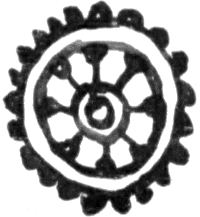dvādaśādhyāyaḥ
lesson 12

padasandhiḥ
External Sandhi

The combination of the final sound of one word with the initial sound of the next.
External Consonant Sandhi
External Vowel Sandhi
Visarga Sandhi
For Sanskrit sandhiḥ in general, Murray Emeneau has compiled a useful collection of exercises called Sanskrit Sandhi and Exercises. I have entered them as Google Forms at the links below. Note that only exercises 1–4 involve external sandhiḥ. The rest of the exercises deal with internal sandhiḥ.
- Exercise 1A: Vowel + vowel (external)
- Exercise 1B: Vowel + vowel (external)
- Exercise 2: Visargaḥ (external)
- Exercise 3: Final nasals (external)
- Exercise 4A: Final stops (external)
- Exercise 4B: Review (external)
- Exercise 5A: Vowel-initial reduplication (internal)
- Exercise 5B: Vowel + vowel (internal)
- Exercise 5C: Vowel + vowel (internal)
- Exercise 5D: Vowel + vowel (internal)
- Exercise 5E: Vowel + vowel (internal)
- Exercise 6A: RUKI (internal)
- Exercise 6B: RUKI (internal)
- Exercise 7: NATI (internal)
- Exercise 8: RUKI (internal)
- Exercise 9A: Aspiration and retroflexion assimilation (internal)
- Exercise 9B: Doubling of ch (internal)
- Exercise 9C: Nasal infixation (internal)
- Exercise 9D: RUKI (internal)
- Exercise 10: Assimilation/RUKI (internal)
- Exercise 11: Nasal infixation (internal)
- Exercise 12: Assimilation (internal)
- Exercise 13A: Nasal assimilation/RUKI (internal)
- Exercise 13B: Voice assimilation/RUKI (internal)
- Exercise 14: Voice and aspiration assimilation (internal)
- Exercise 15: Nasal assimilation (internal)
- Exercise 16: Consonant reduplication (internal)
I have also posted the exercises from the Goldman textbook on the Canvas website and you are encouraged to complete those as well. I will put up solutions upon request.
In addition, all of the selections in the readings section of this website are available in both unanalyzed (post-sandhi) and analyzed (pre-sandhi) forms. You can practice by trying to do the correct sandhi between words in the analyzed version, and seeing if it matches what you see in the analyzed version.
1. Visargasandhiḥ
Note that punaḥ is punar before sandhiḥ.
- rāmaḥ · manyatē (Rāma thinks)
- rāmaḥ · tiṣṭhati (stands
- rāmaḥ · paśyati (sees)
- rāmaḥ · ṭīkām · karōti (writes a commentary)
- rāmaḥ · āgacchati (comes)
- rāmaḥ · anukampatē (feels compassion)
- rāmaḥ · rōcatē (shines)
- rāmaḥ · dadāti (gives)
- rāmaḥ · cintayati (thinks)
- rāmaḥ · badhnāti (binds)
- rāmaḥ · atti (eats)
- agniḥ · jvalati (Agni [fire] blazes)
- agniḥ · parijvalati (really blazes)
- agniḥ · āgacchati (comes)
- agniḥ · tapati (burns)
- agniḥ · rōcatē (shines)
- kanyāḥ · paṭhanti (the girls read)
- kanyāḥ · āsatē (sit)
- kanyāḥ · vicārayanti (think)
- kanyāḥ · tiṣṭhanti (stand)
- kanyē · āsātē (the [two] girls sit)
- punaḥ · āgacchati (comes back)
- punaḥ · īkṣatē (looks again)
- punaḥ · ruṣyati (gets angry again)
- punaḥ · sarpati (slithers again)
- punaḥ · janma (rebirth)
2. Sandhiḥ of final nasals
- tasmin · kṣaṇē (at that moment)
- tasmin · pātrē (in that vessel)
- tasmin · jalāśayē (in that body of water)
- tasmin · avasarē (at that moment)
- tasmin · upasargē (in that misfortune)
- tasmin · śatrau (at that enemy)
- tasmin · cyutē (when that has dropped)
- tasmin · tilakē (in that forehead-ornament)
- tān · śatrūn (those enemies)
- tān · chattradhāriṇaḥ (those parasol-carriers)
- tān · turagān (those horses)
- tān · aśvān (those horses)
- tām · sēnām (that army)
- tam · payōdhim (that ocean)
- tam · arṇavam (that ocean)
- tām · āpattim (that disaster)
- tam · lōkam (that world)
- tān · lōkān (those worlds)
- tān · śūrān (those heroes)
3. External sandhiḥ
Take the following selection of Sanskrit prose and apply sandhiḥ in between words (including between constituents of a compound). Note that when a word ends in a consonant, and the next word begins with a vowel, you should write the sounds together with a single Dēvanāgarī letter.
युष्मत्-अस्मत्-प्रत्यय-गोचरयोः · विषय-विषयिणोः · तमः-प्रकाश-वत् · विरुद्ध-स्वभावयोः · इतर-इतर-भाव-अनुपपत्तौ · सिद्धायाम् · तत्-धर्माणाम् · अपि · सुतराम् · इतर-इतर-भाव-अनुपपत्तिः · इति · अतः · अस्मत्-प्रत्यय-गोचरे · विषयिणि · चित्-आत्मके · युष्मत्-प्रत्यय-गोचरस्य · विषयस्य · तत्-धर्माणाम् · च · अध्यासः · तत्-विपर्ययेण · विषयिणः · तत्-धर्माणाम् · च · विषये · अध्यासः · मिथ्या · इति · भवितुम् · युक्तम् · । तथा · अपि · अन्योन्यस्मिन् · अन्योन्य-आत्मकताम् · अन्योन्य-धर्मान् · च · अध्यस्य · इतर-इतर-अविवेकेन · अत्यन्त-विविक्तयोः · धर्म-धर्मिणोः · मिथ्या-ज्ञान-निमित्तः · सत्य-अनृते · मिथुनीकृत्य · अहम् · इदम् · मम · इदम् · इति · नैसर्गिकः · अयम् · लोक-व्यवहारः · ॥
Translation (in case you’re interested): “Once it is established that it makes no sense for either subject or the object, the domains of which are the concept of “I” and “you” respectively, to be each other, given that their natures are as contrary as light and darkness, it makes even less sense for the properties of each to be each other, and hence it stands to reason that the imposition of either the object, the domain of which is the concept of “you,” or its properties, onto the subject, the domain of which is the concept of “I,” or in the contrary case the imposition of the subject or its properties onto the object, is a mistake. Nevertheless, when the identity or the properties of each one are imposed upon the other, it is completely natural for people to speak in terms such as “I am this” and “this is mine” by pairing what is true and what is false, conditioned by the mistaken cognition of the property and the property-possessor, which are entirely distinct, arising from a lack of discernment regarding each of them.”
